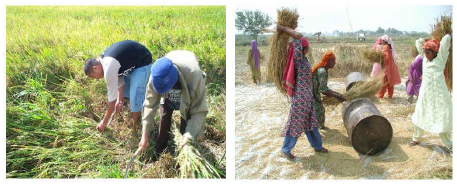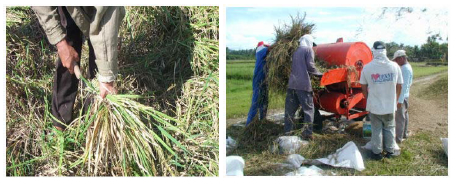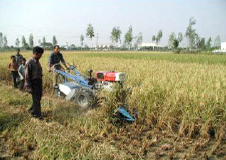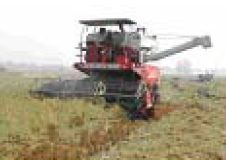Harvesting
What is harvesting?
Harvesting is the process of collecting the mature rice crop from the field. Harvesting consists of cutting, threshing, cleaning, hauling and bagging. Field drying and stacking or piling are optional. Harvesting can be performed manually using sickles and knives, or mechanically with threshers or combine harvesters.
Why is proper harvesting important?
Harvesting at the right time and in the right way maximizes grain yield and minimizes grain losses and quality deterioration.
When to harvest
Harvest according to the grain’s moisture content. This is critical for a good harvest. For more information, see IRRI’s Measuring Moisture Content fact sheet.
| Operation | Desired moisture content (%)* | Primary cause of losses |
|---|---|---|
| Harvesting | 20-25 | Shattering if grain is too dry |
| Mechanical threshing | 20-25 | Incomplete threshing, spillage, grain damage and cracking |
| Hand threshing | <20 | |
| Drying |
|
If drying is delayed: spoilage, fungal damage, discoloration, smell, loss of vigor |
* these moisture contents are tropical, humid climates typical for most varieties and rice-growing countries in Asia.
Harvesting systems
- Manual harvesting
Manual harvesting makes use of traditional threshing tools such as threshing racks, simple treadle threshers and animals for trampling.

- Manual harvesting + machine threshing
Rice is manually threshed, then cleaned with a machine thresher.

- Machine reaping + machine threshing
| A reaper cuts and lays the crop in a line. Threshing and cleaning can then be performed manually or by machine. |  |
- Combine harvesting
| The combine harvester combines all operations: cutting, handling, threshing and cleaning. |  |
Other ways to decide when to harvest:
- Grains should be firm but not brittle when squeezed between the teeth.
- When 80–85% of the grains are straw-colored (yellow in color).
- In the dry season, harvest 28–35 days after heading. In the wet season, harvest 32–38 days after heading.
Harvesting operations
- Cutting - cut the mature panicles and straw above ground.
- Threshing - separate the paddy grain from the non-grain material.
- Cleaning - remove immature, unfilled and non-grain materials.
- Field drying (optional) - leave the cut crop in the field for sun-drying.
- Hauling - move the cut crop to the threshing area.
- Stacking/Piling (optional) - temporarily store the harvested crop in stacks or piles.
- Bagging - bag the threshed grain for transport and storage.
Note: Avoid field drying and stacking/piling, which rapidly reduces quality and increases losses.







